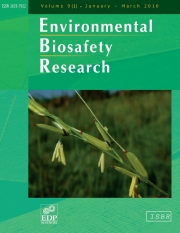Crossref Citations
This article has been cited by the following publications. This list is generated based on data provided by
Crossref.
Holst-Jensen, Arne
2009.
Testing for genetically modified organisms (GMOs): Past, present and future perspectives.
Biotechnology Advances,
Vol. 27,
Issue. 6,
p.
1071.
Ammann, Klaus
2009.
Why farming with high tech methods should integrate elements of organic agriculture.
New Biotechnology,
Vol. 25,
Issue. 6,
p.
378.
Busch, Ulrich
Block, Annette
and
Meißner, Esther
2010.
Gentechnisch veränderte Lebensmittel. Nutzpflanzen nach Maß.
Chemie in unserer Zeit,
Vol. 44,
Issue. 2,
p.
108.
Dietz-Pfeilstetter, Antje
2010.
Stability of transgene expression as a challenge for genetic engineering.
Plant Science,
Vol. 179,
Issue. 3,
p.
164.
Trapmann, Stefanie
Corbisier, Philippe
Schimmel, Heinz
and
Emons, Hendrik
2010.
Towards future reference systems for GM analysis.
Analytical and Bioanalytical Chemistry,
Vol. 396,
Issue. 6,
p.
1969.
Lu, Bao-Rong
and
Sweet, Jeremy
2010.
Challenges and opportunities in environmental biosafety research.
Environmental Biosafety Research,
Vol. 9,
Issue. 1,
p.
1.
Taylor, Matthew C.
Jackson, Colin J.
Tattersall, David B.
French, Nigel
Peat, Thomas S.
Newman, Janet
Briggs, Lyndall J.
Lapalikar, Gauri V.
Campbell, Peter M.
Scott, Colin
Russell, Robyn J.
and
Oakeshott, John G.
2010.
Identification and characterization of two families of F420H2‐dependent reductases from Mycobacteria that catalyse aflatoxin degradation.
Molecular Microbiology,
Vol. 78,
Issue. 3,
p.
561.
Ballester, A.
Cervera, M.
and
Peña, L.
2010.
Selectable marker-free transgenic orange plants recovered under non-selective conditions and through PCR analysis of all regenerants.
Plant Cell, Tissue and Organ Culture (PCTOC),
Vol. 102,
Issue. 3,
p.
329.
Alderborn, A.
Sundström, J.
Soeria-Atmadja, D.
Sandberg, M.
Andersson, H.C.
and
Hammerling, U.
2010.
Genetically modified plants for non-food or non-feed purposes: Straightforward screening for their appearance in food and feed.
Food and Chemical Toxicology,
Vol. 48,
Issue. 2,
p.
453.
Grohmann, Lutz
2010.
Genetic Modification of Plants.
Vol. 64,
Issue. ,
p.
117.
Bertheau, Y.
2011.
Food Chain Integrity.
p.
189.
Peterhansel, C.
2011.
Best practice procedures for the establishment of a C4 cycle in transgenic C3 plants.
Journal of Experimental Botany,
Vol. 62,
Issue. 9,
p.
3011.
Pilacinski, W.
Crawford, A.
Downey, R.
Harvey, B.
Huber, S.
Hunst, P.
Lahman, L.K.
MacIntosh, S.
Pohl, M.
Rickard, C.
Tagliani, L.
and
Weber, N.
2011.
Plants with genetically modified events combined by conventional breeding: An assessment of the need for additional regulatory data.
Food and Chemical Toxicology,
Vol. 49,
Issue. 1,
p.
1.
Perry, Joe N.
Devos, Yann
Arpaia, Salvatore
Bartsch, Detlef
Ehlert, Christina
Gathmann, Achim
Hails, Rosemary S.
Hendriksen, Niels B.
Kiss, Jozsef
Messéan, Antoine
Mestdagh, Sylvie
Neemann, Gerd
Nuti, Marco
Sweet, Jeremy B.
and
Tebbe, Christoph C.
2012.
Estimating the effects of Cry1F Bt‐maize pollen on non‐target Lepidoptera using a mathematical model of exposure.
Journal of Applied Ecology,
Vol. 49,
Issue. 1,
p.
29.
Holst-Jensen, Arne
Bertheau, Yves
de Loose, Marc
Grohmann, Lutz
Hamels, Sandrine
Hougs, Lotte
Morisset, Dany
Pecoraro, Sven
Pla, Maria
den Bulcke, Marc Van
and
Wulff, Doerte
2012.
Detecting un-authorized genetically modified organisms (GMOs) and derived materials.
Biotechnology Advances,
Vol. 30,
Issue. 6,
p.
1318.
Reuter, T.
Alexander, T.W.
and
McAllister, T.A.
2012.
Animal Feed Contamination.
p.
487.
Holck, Askild L.
2012.
Encyclopedia of Analytical Chemistry.
Raybould, A.
Graser, G.
Hill, K.
and
Ward, K.
2012.
Ecological risk assessments for transgenic crops with combined insect‐resistance traits: the example of Bt11 × MIR604 maize.
Journal of Applied Entomology,
Vol. 136,
Issue. 1-2,
p.
27.
Ammann, Klaus
2012.
Encyclopedia of Sustainability Science and Technology.
p.
4492.
Raybould, Alan
Kurtz, Ryan
and
Zeph, Lawrence
2012.
Regulation of Agricultural Biotechnology: The United States and Canada.
p.
317.

